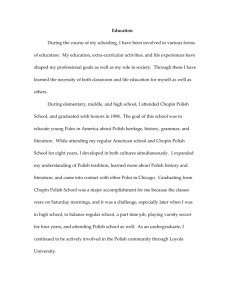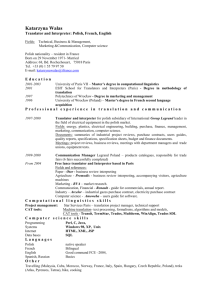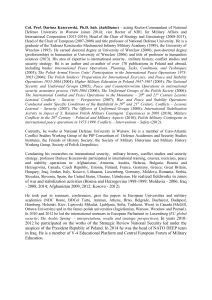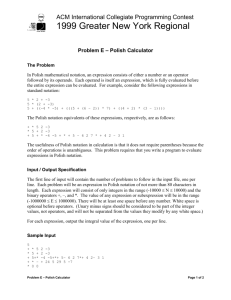The concern in this paper is with Polish
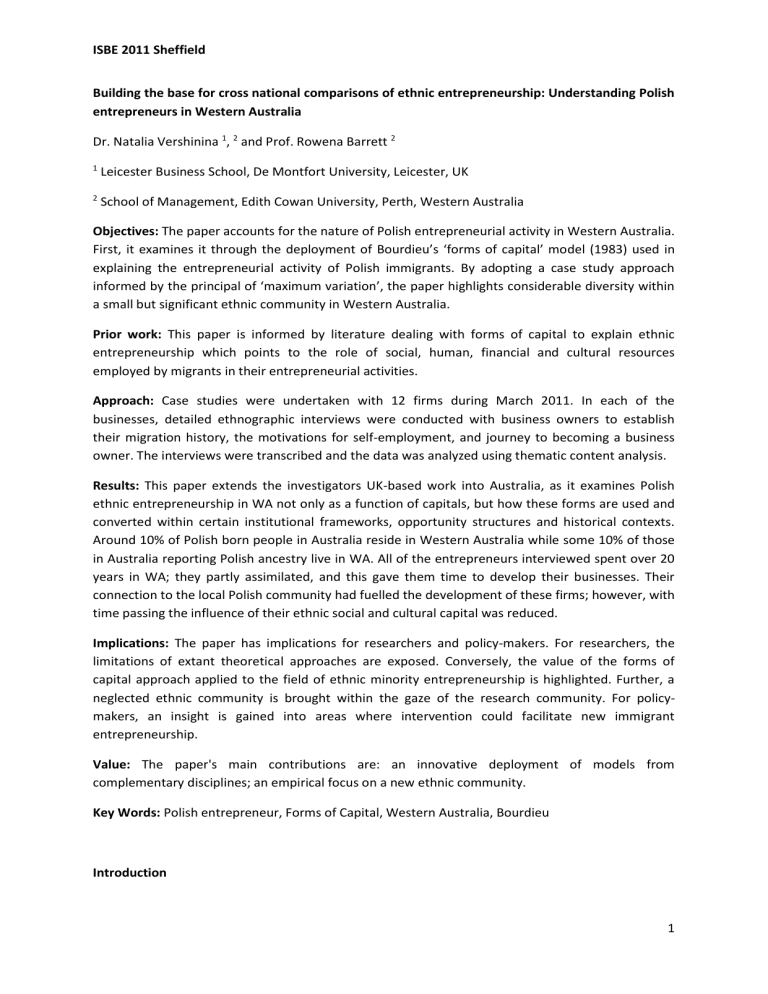
ISBE 2011 Sheffield
Building the base for cross national comparisons of ethnic entrepreneurship: Understanding Polish entrepreneurs in Western Australia
Dr. Natalia Vershinina 1 , 2 and Prof. Rowena Barrett 2
1 Leicester Business School, De Montfort University, Leicester, UK
2 School of Management, Edith Cowan University, Perth, Western Australia
Objectives: The paper accounts for the nature of Polish entrepreneurial activity in Western Australia.
First, it examines it through the deployment of Bourdieu’s ‘forms of capital’ model (1983) used in explaining the entrepreneurial activity of Polish immigrants. By adopting a case study approach informed by the principal of ‘maximum variation’, the paper highlights considerable diversity within a small but significant ethnic community in Western Australia.
Prior work: This paper is informed by literature dealing with forms of capital to explain ethnic entrepreneurship which points to the role of social, human, financial and cultural resources employed by migrants in their entrepreneurial activities.
Approach: Case studies were undertaken with 12 firms during March 2011. In each of the businesses, detailed ethnographic interviews were conducted with business owners to establish their migration history, the motivations for self-employment, and journey to becoming a business owner. The interviews were transcribed and the data was analyzed using thematic content analysis.
Results: This paper extends the investigators UK-based work into Australia, as it examines Polish ethnic entrepreneurship in WA not only as a function of capitals, but how these forms are used and converted within certain institutional frameworks, opportunity structures and historical contexts.
Around 10% of Polish born people in Australia reside in Western Australia while some 10% of those in Australia reporting Polish ancestry live in WA. All of the entrepreneurs interviewed spent over 20 years in WA; they partly assimilated, and this gave them time to develop their businesses. Their connection to the local Polish community had fuelled the development of these firms; however, with time passing the influence of their ethnic social and cultural capital was reduced.
Implications: The paper has implications for researchers and policy-makers. For researchers, the limitations of extant theoretical approaches are exposed. Conversely, the value of the forms of capital approach applied to the field of ethnic minority entrepreneurship is highlighted. Further, a neglected ethnic community is brought within the gaze of the research community. For policymakers, an insight is gained into areas where intervention could facilitate new immigrant entrepreneurship.
Value: The paper's main contributions are: an innovative deployment of models from complementary disciplines; an empirical focus on a new ethnic community.
Key Words: Polish entrepreneur, Forms of Capital, Western Australia, Bourdieu
Introduction
1
ISBE 2011 Sheffield
The Polish people have a long history of migration. Partition, persecution, war, displacement and economic instability as well as changing migration rules have underpinned the ‘multi-faceted trajectory of [Polish] mobility’ (Burrell, 2009: 2). Australia has been one location to receive Polish migrants (Drozd and Cahill, 2004; Smolicz and Secombe, 2009; Smolicz, 1997; Zappala, 1998).
The concern in this paper is with Polish entrepreneurs operating in Perth, Western Australia. Perth is one of the Australian cities to which Polish people have migrated. As a city, Perth has a large and diverse population, actively entrepreneurial ethnic communities, such as Vietnamese, Greek, Italian and Dutch (see Peters, 2002). ‘Ethnic entrepreneurship’ is the term used to describe entrepreneurial activity within minority ethnic groups. This paper aims to extend the investigators UK-based work into Australia and present findings which enable cross-national comparisons. With long histories of ethnic entrepreneurship, Australia and the UK present distinct spatial and regulatory regimes, while
Polish people have filled a niche in each country's social and economic histories. Using a forms-ofcapital approach, the aim of this paper is to explore the ways different groups of Polish entrepreneurs access, use and convert economic, social and cultural capital in their entrepreneurial activity. In the next section of the paper the forms of capital are defined and the ways these can be used and converted such that they create value for ethnic entrepreneurs is discussed.
Theoretical Base: Ethnic Entrepreneurship and Forms of Capital
There have been two main theoretical approaches used to explain why immigrants become selfemployed: the culturalist and the structuralist approaches (Portes, 1995; Ward and Jenkins, 1984).
The core of the culturalist approach focuses on the social embeddedness of individuals within their ethnic culture and that this significantly influences their attitude to entrepreneurial activity. The focus is on social capital in the context of strong family structures which are found in many ethnic cultures to facilitate access to resources such as family capital, family labor and information and/or advice.
The structuralist approach, on the other hand, explains ethnic entrepreneurship in terms of the structures within which ethnic entrepreneurship emerges. The circumstances which immigrants encounter in their effort to gain suitable employment opportunities are critical here. In particular the focus is on the difficulties immigrants face in adapting to their new home country as well as the direct and indirect labour market discrimination they are subject to, such that entrepreneurship provides a means of survival.
As one way of bringing these two theoretical approaches together and overcoming a mono-causal explanation, Waldinger (1986; see also Waldinger, Aldrich and Ward, 1990) proposed an ‘integrative model’. According to this model, ethnic entrepreneurship is a result of a dynamic match between local market opportunities and the local demand and the specific ethnic resources available. The interaction between these demand and supply aspects is facilitated by three classes of factors, namely the characteristics of the ethnic group, the strategies they use and the prevailing opportunity structure. Whilst appreciating the advantages of this model, critiques suggest that it still underplays matters of political economy (Kloosterman, Van Leun and Rath, 1999; Kloosterman and Rath, 2001) and in particular the way personal resources are used in the context of the prevailing economic and regulatory environment (Ram et al., 2008). Many problems ethnic entrepreneurs face are related to socio-political conditions of the host country and include obtaining information, capital, training and skills, human resources, customers and suppliers, competition and various political responses.
2
ISBE 2011 Sheffield
Consequently, they look beyond ethnic strategies and pursue personal and structural strategies, both of which are not confined to ethnic business practices. Hence, exploration of ethnic entrepreneurship in different countries/regions and locations requires a comparison of different opportunity structures and of the markets where potential openings for new businesses could be found (Ram et al., 2008). The ‘mixed embeddedness’ approach therefore provides further insights into micro and macro aspects of ethnic entrepreneurship, as it seeks to explain the development path in terms of the sectoral, spatial and regulatory environments (Ram et al., 2008; Vershinina et al., 2011). This approach does not undermine the importance of ethnic-specific connections, but suggests that the significance of ethnic ties needs to be interpreted in the context of these broader processes. As Peters (2002) points out it is necessary to take into account individual agency of migrants as well as the historical context in which they pursue entrepreneurship. The historical context is critical to understanding inter-ethnic variation and also needs to be considered alongside sectoral, spatial and regulatory environments and their impact on entrepreneurial activity (Peters,
2002; Razin, 2002; Vershinina et al, 2011).
Social capital appears regularly as an explanation for ethnic entrepreneurship, but it is only one important form of capital. Nee and Sanders (2001) examine the forms of capital available within families and ‘how these are used within and apart from the existing structures of ethnic networks and institutions’ (p. 388) to predict the mode of incorporation of Asian immigrants into various labour market trajectories in the USA. In a qualitative study Ram et al. (2008: 440) use this approach
‘to account for the condition of Somalis in business’. Both studies conclude that social capital ‘pays dividends’ (Nee and Sanders, 2001: 408), but as Ram et al. (2008: 440) note, it ‘is conditioned or even subverted by market barriers, under-capitalisation and the associated sectoral and spatial entrapment’. In other words, it is the interplay of these forms of capital that is important to understanding entrepreneurial activity.
What are these forms? Bourdieu (1983: 243) writes ‘capital can present itself in three fundamental guises: as economic capital, which is immediately and directly convertible into money and may be institutionalised in the forms of property rights; as cultural capital, which is convertible, under certain conditions, into economic capital and may be institutionalised in the forms of educational qualifications; and as social capital, made up of social obligations (‘connections’), which is convertible, in certain conditions, into economic capital and may be institutionalised in the forms of a title of nobility’. Each of these forms is briefly expanded below in order to consider their convertibility and use in the context of entrepreneurial activity.
The forms of capital are interdependent with capacity for storage and convertability. Storage can have negative outcomes (Bourdieu, 1983; Light, 2004). Conversion is complex and time consuming as each form ‘contains a tendency to persist in its being’ (Bourdieu 1983: 241). Moreover value accruing from social capital increases in proportion to the individual’s cultural capital as well as economic capital: as a result of learning to speak the language of their new home country individuals can access more connections and opportunities. In the next section a historical account of Polish emigration into Australia is setting the background to the research reported in this paper.
History of Polish Migration
According to Rose (1958) in 1947 Australia started an ambitious migration program designed to accelerate exploitation of its economic resources, give added military strength, and bring relief to as
3
ISBE 2011 Sheffield many Europeans as possible displaced by the war and attendant political upheavals. Although the majority of migrants came from Britain, there was insufficient migration to sustain demographic and economic growth (Castlells 1992). Hence, the Australian government started recruiting Eastern
European refugees, who were perceived as both “racially acceptable” and anticommunist.
Altogether, 180,000 Eastern Europeans migrated to Australia from 1947 and 1951, making up 37 percent of migrants in those years (Collins, 1988: 24).
Jupp (2004) writes that Poles, like the Irish and Italians have a strong history of migration. Most migrated to the USA, but other chose Australia as their destination. There have always been good reasons to leave Poland, but at the same time there was always a strong desire to preserve Polish culture, and more importantly Polish language and relationships with Polish Catholic Church. Polish migration to Australia increased after the Second World War and many of those were Jewish.
Consequently, the Australian Polish community post-1947 was created from scratch and united by
Communism and the fate of Poland. Many of these migrants were displaced persons or political refugees, who left Poland suddenly and involuntary in order to escape Nazis or Communist persecution. However, this small Jewish Polish community was absorbed into the larger Jewish community and did not maintain its distinctiveness.
When the post war migration resumed in 1947, there were only around six thousand Polish-born individuals in Melbourne. In the next seven years it became fifty thousand. Although Melbourne was a preferred destination, there were Polish communities emerging in Sydney, Adelaide and Perth.
Polish migrants of this wave came voluntary during a more liberal emigration policy in Poland.
However, after 1954 further emigration was forbidden by Communists. Numbers peaked at 61000 in
1966 and were based on family re-unions, and then went into slow decline by 1980s. The advent of outlawed Solidarity migrants of 1980s did not make much difference. These were political refugees, who either fled persecution for their activities in the Solidarity movement, or left because they could not tolerate the increasing economic difficulties and lack of freedom in Poland.
Nine thousand more Polish born arrived to Australia between 1986 and 1991, and this brought the
Australian Polish population to a record 70000 people (Jamrozik, 1983). By 1996 the new Polish migrants accounted for one quarter of the total who were aged from thirty-five to fifty. The Polishborn population were predominantly Polish speaking and Catholic in their origin. Whilst it has been reported the one fifth switched to using English in their home, around 70 per cent continued to use
Polish language. This showed high language retention, as Polish language was of ‘core value’ for
Polish community in Australia. (Smolicz and Secombe, 2009) Whilst there was a variety of educational and social background, the majority of Polish immigrants could be described as
“Working class” (Drozd and Cahill, 2004). There was a divergence in educational levels - with one quarter holding university degrees, which was higher than the general population. In terms of occupation, about one third were professionals or semi-professionals, but over a half of this group entered trade, industry or clerical and administrative work. As with other European communities, members of the second generation were better educated than the first.
In our attempt to establish links with Polish immigrant entrepreneurs in Western Australia, a number of Polish owned firms were contacted. The methodological approaches used in this research are presented in the next section.
Methodology
4
ISBE 2011 Sheffield
This project builds on a similar one undertaken by the investigators of Polish entrepreneurs in
Leicester, UK (Vershinina et al., 2011). That study examined ethnic entrepreneurship not only as a function of capital, but how these forms were used and converted within certain institutional frameworks, opportunity structures and historical contexts. Around 10% of Polish born people in
Australia reside in Western Australia while some 10% of those in Australia reporting Polish ancestry live in WA. As neither investigators belong to the Polish community, a Research Assistant with contacts in the Polish community was employed to work with Polish organisations in Perth to facilitate access to potential respondents. Western Australian based organisations included the
Polish Community Council of WA Inc and the Polish Australian Cultural Society. A direct approach was also used as the information about the study (in Polish and English) was left in places where
Polish people meet such as the Polish Club, the Polish Club Cracovia (Inc), the Polish Ethnic School and the Polish Folk Theatre in Perth in addition to Polish and other Eastern European food shops.
Experience suggests this type of approach elicits some interest which is particularly useful when researching sensitive topics or accessing 'hidden' populations (Goodman, 1961; Ram et al., 2008;
Vershinina et al, 2011) and it is recommended then to employ respondent driven sampling techniques for further participant recruitment. The 'old' WA Polish community is located in
Maylands around the Polish Church and School and one of the Polish Clubs, while the 'newer' community is scattered across the metropolitan area.
Twelve firms from different sectors presented in Appendix 1 were recruited for this study with 13 participants. Individual entrepreneurs' participation involved telling their story of coming to Australia and establishing their business. In semi-structured interviews prompts based on the forms-of-capital framework were used for encouragement. Prompts included questions about their emigration history, their community integration and involvement, their family and other connections with
Poland and other countries, their education, values, attitudes and cultural symbols which framed their daily interactions with others. Additionally, motivations for self-employment, when, how and why they established their business and the support, resources and networks they drew upon have been during the interviews. It was pertinent for this study to know how their businesses operate day-to-day. Furthermore, the nature of business information and support, customers, suppliers and workers (i.e. whether they are embedded in co-ethnic networks) were highlighted in a one to two hour interviews. It was expected that their stories would unfold differently but would address socialisation within their family and the impact their values, tangible and intangible forms of support, and education had on the development of their business. Stories were taped and transcribed verbatim before the thematic content analysis helped to find relationships within the data and emerging themes.
The data has been analysed in terms of the forms of capital described, referred to or explicitly mentioned in relation to the ways Polish entrepreneurs used them to establish, develop and operate their business. It was expected that inter-ethnic variation would emerge in this Polish community and so we would be able to gain a better understanding of the support structures and needs of ethnic entrepreneurs in terms of their entrepreneurial development and activity. We generalise the findings back to theory (Eisenhardt, 1989) and our contribution is to show how, when a study is undertaken in the qualitative tradition, and applied within the context of ethnic entrepreneurship, a rich and detailed understanding of the journey to self-employment of these immigrants can be generated.
5
ISBE 2011 Sheffield
The next section of the paper will set the background to Polish emigration to Australia, which helps to understand the wider social, political and economic setting for this entrepreneurs which influenced their decisions to set up a business of their own. The breakdown of the sample is presented in table 1.
Gender
Male
Female
Age
Yrs in AUS
Age of Business
Education
School
College
University
Total
Participants
WWII 1970s
Wave of Migration
Solidarity
(80s-90s)
1
1
59-63
[41-43]
[22-25]
2
13
3
3
[47-51]
[20-31]
[4-27]
2
4
Economic migrants
( after 1990s)
5
[24-45]
[10-20]
[7-19]
3
2
More detailed information on the sample is presented in appendix 1. In the next section is an explanation of how economic, social and cultural capital is investigated in this study of Polish
Entrepreneurs in Perth, Western Australia.
Findings and Discussion
In order to analyse our data we need to provide a brief history of our participants’ migration to
Australia, and the choice which were made at choosing to live in Western Australia.
For a lot of the participants the migration history has made an influence on their status, their assimilation in Australian society and either opened opportunities, or limited their chances for employment. For instance in B’s case she was “... invited to Australia by friends she made whilst working for LOT airline. But it took several years before it happened. She was by 1970 working in
India, when she received paper work to come to Australia and applied for visa in Bombay and came to Perth straight from India. This was instead of returning to her home country, which was of course
under the communist system then.” This decision was not easy, as “the first couple of years she regretted bitterly that she stayed in Australia and burnt her bridges because it wasn’t that easy being
a single girl, twenty-four years of age, without accommodation, looking after herself”.
E decided to “leave Poland because living there was not possible not for her. She could not really believe anything could change and it was exactly 1986 when she left because she went through Italy
and basically escaped as she could not get permission for six years to leave Poland”. She chose
6
ISBE 2011 Sheffield
Australia because her brother has emigrated here in 1980, and she wanted to have somebody she knew around. Being highly educated and involved in Solidarity as a Chairwoman in her work place were the factors that delayed her emigration.
For some of the participants, like in the case of A1, this was a family reunion. For L2 and C the decision to emigrate to Australia was made by their parents. For A2 and J1 living in Australia meant better opportunities for employment, and ability to work for themselves. A2 said “I wanted to see things and to take my chances have a good education in medicine or law, especially as I had no
family to worry about.”
We use a forms-of-capital approach (Bourdieu, 1983; Nee and Sanders, 2001; Ram et al., 2008) to frame our analysis of the interviews undertaken with Polish entrepreneurs in Western Australia. We did this taking into account Bourdieu’s (1983, p. 242) argument that “it is in fact impossible to account for the structure and functioning of the social world unless one reintroduces capital in all its forms and not solely in the one form recognised by economic theory”. The forms of capital we considered were those as Bourdieu (1983) originally outlined – economic capital, social capital and cultural capital. With the help of Light (2004) we could clearly see how these different forms could be stored and their capacity for convertibility into other forms, which is a key to understanding entrepreneurial activity.
We found that social capital arising from a shared Polish nationality and ethnicity or the same country of origin was only one form used by these Polish entrepreneurs. Some interesting similarities emerged between these ethnic entrepreneurs and more traditional accounts of entrepreneurship. For instance, at face value the reasons for becoming self-employed were similar to the general motivations for entrepreneurship including the desire for financial independence, autonomy or seeking better life work and life conditions in the market which they could exploit with their product or service through the “opportunities”, as well as such “push” Williams (2005) motives as inability to find a regular job due to the immigration status limitations.
For example a financial motive can be seen when B says that she “... saw people that came to visit
from Australia, and she wanted to copy their financial success”. This motive is echoed in the story of
E, who mentioned that “it was really hard time in Poland, and I was looking for a new life”. The quest for autonomy is apparent in A2’s comment that, “When I finished my education, I knew I would start
my own Law Firm”, and in V’s comment: “I wanted to earn more money and was looking for more
freedom (I don’t want to go to work every day)”. J2’s passion for the industry that underpinned her move into self-employment is clear when she explains that after many years of working in catering industry she was keen to “open a new restaurant with her partner “I was the best baker and had a
lot of experience in restaurant business, and I liked it.” However, a lot of the motivations amongst this group of Polish immigrants have been influenced by the operating conditions in Poland. V illustrated that “depression, being pushed around and having no voice; you are scared to do anything
so that you don’t get punished. That was so depressing, I just couldn’t take that”. L2 went into selfemployment having qualified as a migration agent due to lack of challenge fin her previous employment: “I became stale and was doing the same thing over and over again and you know just dealing with it’s not real kind of business situation so this gives me the challenge of meeting people,
selling myself, doing something that counts and earning some money as well.”
7
ISBE 2011 Sheffield
While the motivations for becoming self-employed for this group were not dissimilar to what other studies of the self-employed have shown (Storey, 1994) what is interesting is the various ways these immigrants combined the forms of capital available to them and converted them to facilitate entrepreneurship in Australia.
Forms of Capital and Paths to Entrepreneurship
By looking at different forms of capital were able to see how value could be realised from the different forms of capital. This enabled us to observe variations in the rationale for self-employment with motivations ranging from starting a business that reflects the individual’s skills set or professional qualifications to seeing an opportunity to serve a niche market or simply desiring to make money as well as similarities and differences in the ways the different forms of capital were used,. Essentially the path to entrepreneurial activity was influenced by the environment in which the different individuals grew up, whether in Poland or Australia, their family upbringing, the way they perceived and perceive their life’s objectives. The time spent in Australia was important to the development of their social and cultural capital. Those who emigrated to Australia earlier and/or were residing in Australia through family re-union or marriage to an Australian citizen, clearly had a better understanding of how the economic, social and financial systems operated in Australia, compared to other migrants. They also had more time to build economic capital which could be put to effect in their entrepreneurial activity. However the long history of Polish immigration to Australia also meant that newer arrivals were able to tap into the social networks that had been established by previous waves.
Table 2: Forms of capital used by Polish entrepreneurs in WA
Economic capital Money
Social capital
Assets
Networks
Family
Cultural capital Embodied (knowledge)
Objectified (goods)
Institutionalised (qualifications)
The forms of capital employed by these Polish entrepreneurs are apparent in Table 2. These entrepreneurs have accumulated considerable levels of economic capital. Some had kept property and assets in Poland, but the majority of what these people had accumulated was from working and living in Australia. Social and cultural capitals are largely developed within the confines of the family.
The differences between the varying degrees of networks and cultural symbols used and converted by Polish entrepreneurs in their business activity could largely be attributed to the length of time
8
ISBE 2011 Sheffield these individuals have spent in Poland and Australia. Bourdieu (1983) explains this in terms of family socialisation, and this is what unites the individuals as their families are still in Poland and therefore individuals had strong social and cultural connections in and with Poland.
Linguistic differentiation also represents an important social marker. All of the participants spoke
Polish in their home, however, this was not applicable to C, who was four years old when her mother
J2 made a decision to leave Poland. C was brought up in Sweden for the first few years and then
Australia for the majority of her youth. She considers herself as Australian with Polish roots, even though she does not have Polish language skills. C says, “because we’re Poles I always tell everyone
I’m of Polish background”.
The community plays an important role in helping individuals to retain Polish values. As C described:
“Aussie kids don’t care what you do or what your parents do. Polish kids do, very much so. They are interested in what you earn, where you go to school, what your studying, who your partner is... for example [Polish First name and Surname] is a perfect example: her boyfriend is Australian but they’re all about image, looking nice, cars, fancy holidays, and then you look at me and my boyfriend who do
everything together but we are not big on image”.
Learning to speak English was the first step for all participants to extend their social capital. For J2, amongst others, “the most important thing on visa application was the age, language, of course the
money and education. So we actually got everything quite all right.” A1 however, continued to
“speak Polish to [her] kids”, who sometimes helped out at her cafe. Because they work with a lot of
Polish customers and suppliers, everyone in store needs to speak Polish and English. As Bourdieu
(1983) points out, often some forms of capital increase in parts. For instance, migrants’ social capital increases their language skills as J1, L1 and L2 mentioned, they acquired more social capital after starting to learn English language. For A2 (unlike other respondents) in his case there was no help from friends or family residing in Australia, but investing in cultural capital via learning English language and Law at Murdock University and socialising with English speaking classmates helped him increase his social capital in Australia: “I did everything myself. I learnt English quickly and I made
friends with local people and foreigners from other countries.”
In E’s case, her Masters education from Poland in pharmaceutical science was not recognised in
Australia, and to work as a pharmacist, she needed to do further qualifications, which takes a lot of time that she did not have. She was almost 40 years old at the time. In essence this inability to convert the degree pushed E into self-employment.
The Polish community also gave a start to a few businesses. In the case of M3, her bookstore was the sole provider of Polish language books and newspapers, and it was located in Maylands, one of the key Polish clusters in Perth. Her business was created to serve the ethnic niche, and the Polish community fuelled her business success. M3 was quick at recognising that with very few migrants from Poland in the years since opening a store, she had to diversify into other Eastern European ethnic groups, but also develop a portfolio of products that would reflect the needs of the mainstream market. M3 explains that “eighty percent of [her] customer base was Polish customers, but [she] not only ran a bookshop but enlarged it. [She] had Polish glass, Polish porcelain, some nice toys and a few times organised an art exhibition. The artists were not only Polish but some of them were Australian. So [she] sold paintings and on Christmas the shop became very popular in the whole
Perth because [she] was importing the special glass ball Christmass decorations”.
9
ISBE 2011 Sheffield
A2’s story is somewhat different. He says: “my initial clients were actually from Polish community. It was Polish community who gave me a start admittedly, although now we don’t have that many members of Polish community. This helped obviously because it was a natural target, but it’s also a very difficult community to deal with, as they expect you to do things for them for free. I am not that
keen on this type of clients and now we are simply one of many law firms in Perth...” This was a decision that may have broken the links with the community; however, it allowed the business to become financially stable.
A1’s business exhibits all the typical Polish cultural characteristics. The core food items on the menu at her three locations in Perth are of Polish origin. It is a well known place which sells the best Polish donuts in Western Australia. This connection with Polish cultural symbols does not stop there. A1 explains: “There is a Polish club Cracovia, there is the Polish dancing group at the club, which we are kind of like the sponsors. My girls dance in this group, and we travel a lot around Australia and share
our Polish culture with a lot of people. This also allows me to promote our business”.
What can be seen from these examples is that all of the entrepreneurs interviewed, who spent over
20 years in WA have partly assimilated, and this gave them time to develop their businesses. Their connection to the local Polish community had fuelled the development of their firms; however, with time passing the influence of their ethnic social and cultural capital was reduced. Although some of the participants continue to forge new connections with now decreasing Polish community in
Australia, the children of these migrants are not as embedded within the Polish community in
Australia.
Conclusions
This paper is located within the qualitative studies of entrepreneurship and case studies of thirteen first generation Polish immigrant entrepreneurs operating in Australia are presented in detail in order to illuminate the nuances of ethnic group capitals utilised in their business development. Our interest is in their experience of being entrepreneurs and we focus on first generation Polish immigrants in this paper, whose stories we found to be rich and detailed when we undertook study of entrepreneurship in the Polish immigrant community in Perth, WA in March 2011.
Our study is situated within the ‘ethnic entrepreneurship’ or ‘immigrant entrepreneurship’ literature where it is suggested that entrepreneurship is an economic survival strategy used by immigrants as a means of overcoming the difficulties and discrimination they face in adapting in their new homeland. In particular the thrust of this literature is that immigrants have limited access to some forms of capital and so rely on social capital in their entrepreneurial activity.
It is important to reiterate the importance of Forms of Capital approach (Nee and Sanders, 2001;
Bourdieu, 1983) for studies of ethnic migrant entrepreneurs. In this case, this approach was applied to a group of Polish immigrant entrepreneurs who chose to settle in Australia for various reasons. By using this framework we were able to highlight the origins and importance of financial, social, human and cultural capital Polish entrepreneurs used, accumulated and converted for their business activity.
10
ISBE 2011 Sheffield
The different wave of migrant from Poland had different paths to entrepreneurship, but in the end all started by serving the Polish ethnic community, an d the majority broke out to work with mainstream clients and suppliers. In this sense, the findings of this study are not dissimilar to those of other ethnic groups. However, the Polish cultural background, and political reasons for migration, and opportunities available to these people in Australia make this study quite unique. As one of the respondents said: “I strive to derive benefits of the best aspect of this country and the other country”. But would their entrepreneurial journey have been repeated if they ended up immigrating into a different country?
The prevailing opportunity structure in Australia was a particular finding specific to success of a lot of ethnic entrepreneurs. Similarly to Peters (2002) - a study of various ethnic entrepreneurs from
Dutch, Italian, Greek and Vietnamese groups - Polish ethnic entrepreneurs utilise their personal resources in the context of the prevailing economic and regulatory environment in Western
Australia having left the difficult and less promising environment of Poland. Many problems ethnic entrepreneurs faced were similarly related to socio-political conditions of the host country and included obtaining information, capital, training and skills, human resources, customers and suppliers, competition and various political responses. Consequently, in our study Polish entrepreneurs looked beyond ethnic strategies and pursued personal and structural strategies, both of which are not confined to ethnic business practices.
The forms of capital framework enables us to show how the value of capital changes with use: value can increase or decay with storage and what can be used at one point in time may not be available or valuable at another. Moreover, by framing the stories of Polish entrepreneurs around forms of capital we show that social capital widely embraced by ethnic entrepreneurship researchers (Jones and Ram, 2007), while important, is only one form of capital pertinent to ethnic entrepreneurial activity and business growth and development.
The paper has implications for researchers and policy-makers. For researchers, the limitations of extant theoretical approaches are exposed. Conversely, the value of the forms of capital approach applied to the field of ethnic minority entrepreneurship is highlighted. Further, a neglected ethnic community is brought within the gaze of the research community. For policy-makers, an insight is gained into the waves of Australian migration, and areas where intervention could facilitate new immigrant entrepreneurship.
11
ISBE 2011 Sheffield
Appendix 1 Participants Information
Participant
M1
M2
M3
A1
J1
B
A2
L1
L2
E
C
(daughter)
J2
(mother)
V
Gender Sector
F
F
M
F
M
F
F
F
F
M
F
F
M
Services
Cafe
Book retail
Cafe
Year of migration
Age of the
Business
1982
1999
1983
1981
Construction 1987
Travel
Legal
Vet
Services
Beauty
Cafe
Cafe
Art & Design
1970
1982
1991
1980
1988
1988
1988
1986
1993
2004
1984
1982
1992
1989
1991
2004
2007
1991
1989
2007
1991
How Many employees
(Polish)
2 (2)
6 (2)
2 (2)
10 (4)
3 (2)
3 (2)
10 (2)
10 (1)
1 (1)
2 (1)
2 (2)
Highest Qualification
School Poland
College Poland
College Poland
College Poland
Technical and Further
Education college AUS
Technical and Further
Education college AUS
University AUS
College AUS
University AUS
University Poland
University AUS
2 (2)
4 (1)
High School Poland
University AUS
12
ISBE 2011 Sheffield
References
Bourdieu, P. (1983) ‘The forms of capital’, in J. Richardson (ed.) The Handbook of Theory and
Research for the Sociology of Education (241-58). New York: Greenwood Press.
Burrell, K. (2009) ‘Introduction. Migration to the UK from Poland: Continuity and change in east-west
European mobility’, in K. Burrell (ed.) Polish Migration to the UK in the ‘New’ European Union:
After 2004 (1-22). Aldershot, Asgate.
Castles, S. (1992) ‘The Australian Model of Immigration and Multiculturalism: Is It Applicable to
Europe?’, International Migration Review, Vol. 26, No. 2, Special Issue: The New Europe and
International Migration (Summer), pp. 549-567.
Collins, J. (1988) Migrant Hands in a Distant Land: Australia's Post-War Immigration. Sydney: Pluto
Press.
Dana, L.P., and Dana, T.E. (2007) ‘Collective entrepreneurship in a Mennonite community in
Paraguay’, Latin American Business Review, 8(4): 82-96.
Drozd, E. and Cahill, D. (2004) Polonia in Australia: Challenges and Possibilities in the New Millenium,
Altona, Vic: Common Ground Publishing.
Düvell, F. (2004) Highly Skilled, Self-Employed and Illegal Immigrants from Poland in United Kingdom.
Working Paper No.4, Centre for Migration Studies, Warsaw.
Eisenhardt, K.M. (1989), ‘Building theories from case study research’, Academy of Management
Review, 14, 532–50.
Goodman, L.A. (1961) ‘Snowball sampling’, Annals of Mathematical Statistics, 32: 148-70.
Jamrozik, A. (1983) The New Polish Immigrants: A Quest for Normal Life, Sydney: Ethnic Affairs
Commission of New South Wales.
Jones, T., and Ram, M. (2007) ‘Re-embedding the ethnic business agenda’, Work, Employment and
Society, 31(3): 439-57.
Jupp, J. (2004) The Polish Impact on Australia Society in Drozd , E. and Cahill, D. (2004) Polonia in
Australia: Challenges and Possibilities in the New Millenium, Altona, Vic: Common Ground
Publishing, p.9-19.
13
ISBE 2011 Sheffield
Kloosterman, R., Van Leun, J. and Rath, J. (1999) ‘Mixed embeddedness: Immigrant entrepreneurship and informal economic activities’, International Journal of Urban and Regional
Research, 23(2): 253–67.
Kloosterman, R., and Rath, J. (2001), ‘Immigrant entrepreneurs in advanced economies: Mixed embeddeness further explored’, Journal of Ethnic Migration Studies, 27(2), 189-202.
Light, I. (2004) ‘Social capital’s unique accessibility’, Journal of American Planning Association, 70(2):
145-51.
Nee, V. and Sanders, J. (2001) ‘Understanding the diversity of immigrant incorporation: A forms-ofcapital model’, Ethnic and Racial Studies, 24(3): 386-411.
Peters, N. (2002) ‘Mixed embeddedness. Does it really explain immigrant enterprise in Western
Australia (WA)?’ International Journal of Entrepreneurial Behaviour and Research, 8(1/2): 32-53.
Portes, A. (1995) ‘Economic sociology and the sociology of immigration: A conceptual overview’, in
A. Portes (ed.) The Economic Sociology of Immigration. Essays on Networks, Ethnicity and
Entrepreneurship (1-41). New York: Russell Sage.
Ram, M., Theodorakopoulos, N., and Jones, T. (2008) ‘Forms of capital, mixed embeddedness, and
Somali business enterprise’, Work, Employment and Society, 22(3): 427-46.
Razin, E. (2002), ‘The economic context, embeddedness and immigrant entrepreneurs’, International
Journal of Entrepreneurial Behaviour and Research, 8(1/2), 162-167.
Rose, A.J. (1958) ‘The Geographical Pattern of European Immigration in Australia’, Geographical
Review, Vol. 48, No. 4 (Oct), pp. 512-527
Smolicz, J.J. (1997) ‘Australia: From Migrant Country to Multicultural Nation’, International Migration
Review, Vol. 31, No. 1 (Spring), pp. 171-186
Smolicz, J.J. and Secombe, M. ( 2009) ‘Globalisation, Values and Human Rights for Cultural Diversity’,
Globalisation, Comparative Education and Policy Research, 7(1), pp.35-47.
Storey, D. (1994) Understanding the Small Business Sector . Routledge: London.
Vershinina, N., Barrett, R., and Meyer, M. (2011) ‘Forms of capital, intra-ethnic variation and Polish entrepreneurs in Leicester’, Work, Employment and Society, Vol 25, No. 1.
14
ISBE 2011 Sheffield
Waldinger, R.H. (1986), Through the Eye of a Needle: Immigrants and Enterprise in New York’s
Garment Trades, New York: New York University Press.
Waldinger, R., Aldrich, H., and Ward, R. (1990) ‘Opportunities, group characteristics and strategies’, in R. Waldinger, H. Aldrich and R. Ward (eds) Ethnic Entrepreneurs: Immigrant Business in
Industrial Societies (13-48). Newbury Park CA: Sage.
Ward, R., and Jenkins, R. (eds.) (1984), Ethnic Communities in Business, Cambridge, Cambridge
University Press.
Williams, C.C. (2005) ‘The undeclared sector, self-employment and public policy’, International
Journal of Entrepreneurial Behaviour & Research, 11(4), pp. 244 – 257.
Zappala, G. (1998) "Clientelism, Political Culture and Ethnic Politics in Australia", Australian Journal
of Political Science, vol. 33, no. 3, pp. 381-397.
15


